Significant achievements from archaeological excavation of Chengba site in Sichuan Province
Chengba site is located in Tuxi Town, Qu County, Dazhou City, Sichuan Province. From 2014 to 2018, five successive seasons of systematic archaeological survey, prospection and excavation of the site have been conducted jointly by Sichuan Provincial Institute of Cultural Relics and Archaeology and History Museum of Qu County. Excavated area adds up to 4000 square meters. There are 438 features of all kinds being cleared, including 44 tombs, 11 wells, 331 ash pits, 2 sections of city walls, 1 city gateway, 4 housing foundations, 37 ditches, 6 kilns and so on. A number of artifacts from the late period of Warring States to Wei-Jin periods have been unearthed. Great achievements have been made from these years’ works.
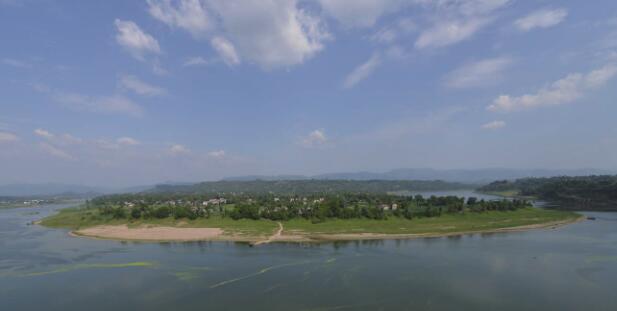
Distant view of Chengba site
Main Remains
Functions of different sections of Chengba site have been basically figured out. The site consists of city ruin, ordinary settlements, kiln remains, cemetery area, well area and so on.
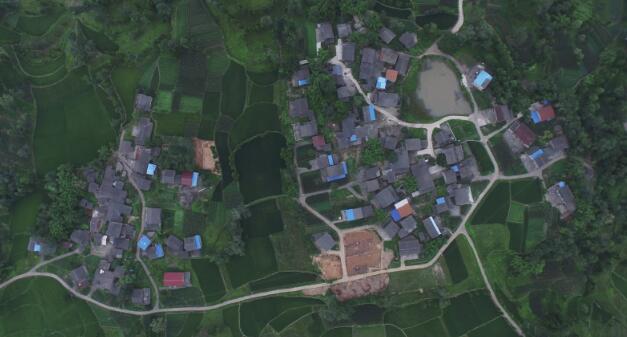
Arial photo of the site
City Ruin
Guojiatai city ruin is located on the third terrace of northeast part of Chengba site. It has a slightly square plane, while the city wall in the northeast part is inward due to topography. The city is about 260m long from south to north and roughly 240m in the widest part from east to west. It covers almost 50,000 square meters. From 2017 to 2018, southwest part of the ruin has been excavated. Different kinds of features have been found and cleared, ranging from moats, city walls, city gate, roads, architectural foundations, water wells, pits, drainge and etc. They are correlated and form a unity. These findings not only play an important role in research on the meaning and periodization of Guojiatai city remains, but also are of great values in exploration of construction and developments of cities of Han-Jin Dynasty.
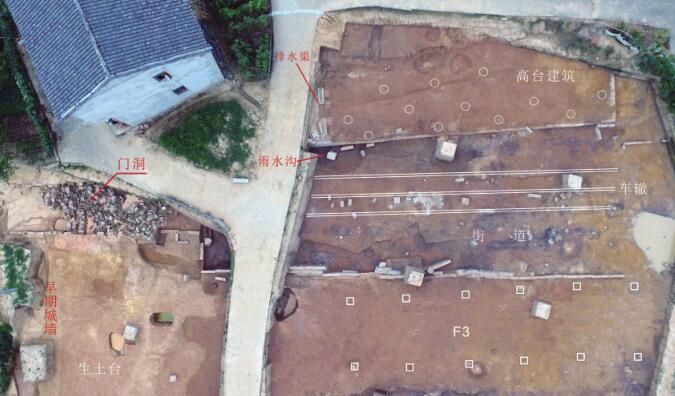
Distribution map of its building
Tombs
Tombs are used from the late period of Warring States periods to Western Han Dynasty to Wei Jin periods. Among them, those from the late period of Warring States periods to Western Han Dynasty are all earthen shaft pit tombs. So far, 44 tombs have been excavated, which are all from Western Han Period. They are all earthen pit tombs and wood coffin-chamber tombs. The number of the latter is much more than the former. Besides, there are much richer burial gifts being discovered from wood coffin-chamber tombs, including copper artifacts, iron artifacts, pottery, lacquer-ware and so on. Tombs from Chengba site were used for a relatively long period of time. From tomb forms and burial goods, multiple cultural factors are recognized, reflecting there were multicultural developments under the unification of Qin and Han Dynasties.
Wells
There are plenty of well remains being found within Chengba site. However, only 55 have been discovered by archaeological prospection. So far, 11 water wells have been cleared from archaeological excavation, which are mainly distributed in two main areas, that is, the periphery of the buildings and intensively distributed well area. Wells in the former area might be related to daily water use of local people, while wells in the latter area may be irrigation facilities. These wells are basically constructed in the same methods, which are all made by pottery walling cribs. There are 3 wells made of walling cribs with tenon-mortise structure being used within Chengba site since Han Dynasty.
Kiln remains
Three semi-subterranean kilns are cleared from excavation. They all have five parts, including an operating room, a fire door, a fire stove, a kiln chamber and smoke extraction facilities. The forms are rather similar with those of pottery kilns from Chang’an City from Han Dynasty. Three kilns are placed in order. Plenty of pan-tiles unearthed from the kilns are the same with those from the city, which indicate that these pan-tiles were made specifically for construction of buildings in the city under centralized management.
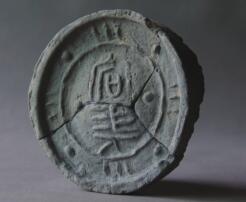
Eave tiles with Chinese characters “dang qu”
Unearthed artifacts
There are more than 1000 pieces of important artifacts from the late period of Warring States to Wei-Jin periods being discovered from Chengba site up to now. Among them, the most significant finds are eave tiles with Chinese characters “dang qu”, which are all uncovered inside the city. So far, almost 10 pieces of eave tiles have been unearthed and 3 of them are relatively well-preserved. The discovery of eave tiles with Chinese characters “dang qu” suggests that Chengba site was “Dang qu” City in which documented in Qin-Han Dynasties texts. The results of archaeological excavations are basically in accordance with establishment and abandonment dates of “Dang qu” county recorded in historic texts. It’s very rare to uncover bamboo writing slips in archaeological excavations in Sichuan. This is the third discovery of bamboo slips that 15 pieces of slips from Han Dynasty have been found besides wood slips found in Qingchuan from Warring States, medical slips uncovered in Laoguanshan cemetery from Han Dynasty. Most of the slips are incomplete. All together there are more than 200 characters being found. Most of them are from the middle and late periods of Western Han Dynasty to the middle and late periods of Eastern Han Dynasty. Rich contents have been documented, including “A Text on Cang Jie” as reading primer in Han Dynasty and as well formal official documents with exact dates such as “the second year of He-ping reign”, “the first year of Jing-ning reign” and so on.
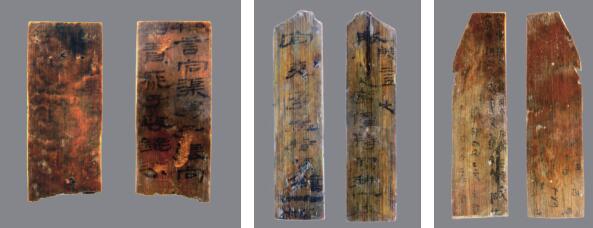
Bamboo slips
Archaeological discoveries of Chengba site reveal complex and combination characteristics of the late phase of Ba Culture in Qujiang River Area and its cultural reaction with periphery areas. This suggests complex relationships between groups within the unique geographical and political spheres. Meanwhile, these finds provide important materials for further discussions on Qin-Han Empires’ managements of southwest areas and construction of local administrative system. (Translator: Ma Huanhuan)

